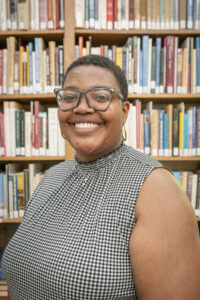This post is part of our blog series “Scholars Speak,” which features writing from our 2025 cohort of Preservation Scholars. Click the link to learn more about this donor-funded program that aims to increase the breadth of voices in the Texas historical narrative by placing students from underrepresented cultural and ethnic backgrounds in paid, 10-week long summer internship positions at the Texas Historical Commission.
Scholars Speak: My Journey with Henrietta and Cora Faye

Last week, our Preservation Scholar Program lead asked us in our weekly check-in, “What has been an ‘Aha!’ moment for you this week?” Although I answered the question sharing information I gained from the genealogical research I did, I believe I now have a different answer to the question.
Coming into the internship program, I considered myself to be moderately knowledgeable on the storied and complex experiences of African Americans in the South in the 1800s. I’ve read books, gone to museums, seen movies, had conversations, done research, and talked with the elders in my family. However, being on site at the Varner-Hogg Plantation and transcribing the oral histories of the descendants of those once enslaved has shifted my world on its axis. These were stories that I once considered history worth knowing and found impactful to my “becoming” as a young person. However, these very stories have turned into the shoes I try to step into daily, and the lives I fight to make sense of through census records, old county maps, tax assessment reports, and recorded personal retellings.
What once felt worlds apart has become almost unavoidable. There is one story that instilled itself into my bones and will never leave my side again. Her name is Henrietta. She was the daughter of an enslaved indigenous woman (woah, right?), Ellen, and the man that owned them. They came from Virginia and eventually settled near the Patton Plantation, now Varner-Hogg, between 1855-56. There are financial records that suggest they may have been in Brazoria County for at least more than a decade before they came to Patton, but it is unclear. I find it unfortunate that the enslaved were rarely identified by name, likeness, or personality, unless they were for sale or had attempted to escape in search of freedom.
Henrietta, like many, chose to live near where she was set free at the age of 15 in 1865, and started her family. About 40 years later, after the death of one of her daughters-in-law, she helped raise three of her granddaughters. The oldest granddaughter, Cora Faye, eventually became her family’s historian, and therefore, the reason I am able to share this history. As my family’s historian for my generation, I quickly saw myself in Cora Faye and understood her curiosity revolving around her grandmother, Henrietta. Who was she? What happened to her mother? Why did she stay? Why did she hesitate to share her story with Cora Faye?
Currently, only so much is known based on what Cora Faye shared, and what Angela Pfeiffer, THC’s Curator at Varner Hogg and Levi Jordan Plantation State Historic Sites, and I have helped to confirm through research. Many of the questions will probably remain unanswered because this is often the case with family-documented by descendants of the enslaved. Lives, stories, and identities are lost to death because they were not afforded the freedom of oral preservation. There is great value in everyone’s story, and as history progresses, passing these stories through oral tradition must be a practice we all cling to as we faithfully preserve the lives we’ve lived.